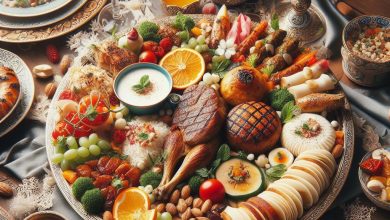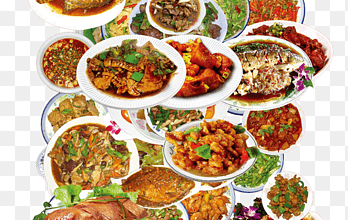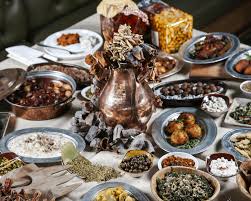Turkish Food

No need to think that Turkish lahmacun is Turkish pizza or Turkish manti ravioli. Yes, these dishes are similar to their opponents, but they do not have translations into Russian, English or any other language (besides Turkic and Arabic, probably). The dishes presented below are considered by the Turks to be the original Turkish cuisine.
I won’t say how true it is that the dish appeared in Turkey and was not created following the example of another, I have not studied this issue yet. Nevertheless, let’s list those Turkish dishes that are not in European cuisine, although perhaps they are similar to some national treats of other countries, or they are not translated into Russian (borrowed words).
Turkish Cuisine
Borek – Borek. A confectionery dish made from layers of yufka (see below), baked in various shapes and styles, and usually stuffed with: white cheese (peynirli), kashar (kaşarli), spinach, potatoes, minced meat. It can be translated as a pie, however, it is a pie, and a pie, and a cheesecake, and sour cream, and a bunch of representatives of the flour industry.
The most popular options for the coast are: Gül Boreği – the shape of a rose; Sigara Boreği – crispy short rolls; Kol Böreği – elongated and crispy pies; Su Boreği is literally a water pie made from layers of dough, baked in the oven with white cheese and smeared with milk and egg.
Raw cutlet – Çiğ köfte. Although the name means raw cutlet, due to the new rules, this dish is no longer made with raw meat (in Istanbul, at least in most places), instead of meat, bulgur with a mixture of vegetables and spices is put. This mass is mixed, kneaded for a long time and formed into pies. Served mainly with lettuce leaves, pomegranate or spicy sauce, sometimes with thin pita bread.
Dolma – Dolma. The literal translation is “stuffed”, “filled” (as in dolmuş, a Turkish minibus) There are also differences here – meat, vegetable, rice filling in grape leaves (yaprak dolma), cabbage leaves (lahana dolma), peppers (biber dolma), courgettes (kabak dolma), tomatoes (domates dolma), eggplants (patlıcan dolma). Moreover, the vegetables that are stuffed can be fresh, pickled, dried, frozen … These are not cabbage rolls, even in a cabbage leaf, there is a tiny dolma, for 1-2 bites.
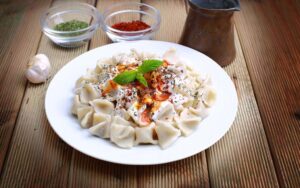
Doner – Doner. Either meat (etli döner) with lamb, beef or a combination of different meats, or chicken (tavuklu döner). These are layers of meat, poultry, which are cooked on a spit near a special electric stove. You could see such designs at shawarma sellers. The slices fried in this way are wrapped in pita bread with the addition of vegetables and fried potatoes, or placed on bread pide (iskender) soaked in boiling butter with tomato sauce, or placed on top of rice (pilav üstü), or a sandwich is made (ekmek arası).
Ice cream – Dondurma. Taken from the Turkish word “freezing”, this is ice cream, yes, but only relatively recently it has become like ours and European ones, before dondurma was made exclusively with the addition of salep and mastic. These two components give Turkish ice cream its own viscosity and distinguish it from other analogues. Also known is the Turkish ice cream Maraş Dondurma, which is made exclusively using this technology.
Durum – Durum. As a rule, this is meat or a cutlet wrapped in thin pita bread, sometimes in a thick one, smeared with butter.
Ezogelin – Ezogelin. The Bride’s Soup is made from a mixture of different types of wheat, flavored with dried herbs and spices.
Gozleme – Gozleme. Stuffed flatbread usually made while seated. The dough is rolled out very well, with dexterous craftsmanship, then filled with spinach, minced meat, cheese or potatoes, folded to cook in a cast iron skillet.
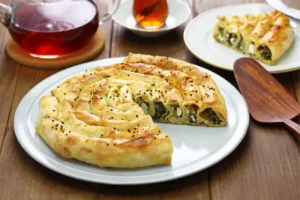
Ichli kofte – İçli Köfte. Popular snack or street food. It is made from spicy minced meat with the addition of nuts in a crispy shell of bulgur or potatoes.
Kofte – Kofte. Cutlets, meatballs, as a rule, are made from lamb, beef, very rarely from chicken. Varieties include: kadınbudu köftesi – “lady’s thighs” – fried cutlets in an egg, Sulu Köfte – small meatballs in tomato sauce. You can also find balık köftesi (fish cakes), Mercimek köftesi (lentil balls), and Sebze köftesi (vegetarian versions).
Kokorech – Kokoreç. Lamb intestines wrapped around seasoned offal. A common sight on many street corners, this dish is cooked on a horizontal spit over coals, then finely chopped and layered on half a white Turkish bread.
Lahmacun – Lahmacun. It sounds strange to the Russian ear, doesn’t it? A rough translation is “meat with dough in Arabic.” Lahmacun is a thin round piece of pastry topped with minced meat, finely chopped tomatoes, onions and herbs, usually cooked in a wood fired oven to crispy perfection. Lemon is poured over the finished cake, vegetables are placed in the middle and wrapped for the convenience of eating the dish. You need to eat with your hands.
Manty – MantI. These are a kind of small dumplings, usually filled with a crumb of spicy minced meat. They are frozen or dried, then cooked. Served with garlic yogurt and oil-fried red chili peppers.
Muhallebi – Muhallebi. This is the so-called pudding with a hint of mastic based on milk with rice flour and rose water. Muhallebici (pudding makers) often sell a wide range of similar dishes with different variations and flavors.
Nar Ekshisi – Nar Eksisi. I call it pomegranate sauce. It is a sweet and sour pomegranate juice sauce prepared as a thick, dark syrup. Used in salads instead of balsamic vinegar, also delicious with meat or sautéed onions.
Basturma – Pastırma. Air-dried spicy beef. Often served in thin slices with eggs or hummus. Feature of the province of Kayseri.
Pekmez – Pekmez. A sweet mass most commonly made from grapes, figs, carob, or mulberries. it’s a kind of molasses. Pekmez is sometimes mixed with tahini, served for breakfast or used to create desserts.

